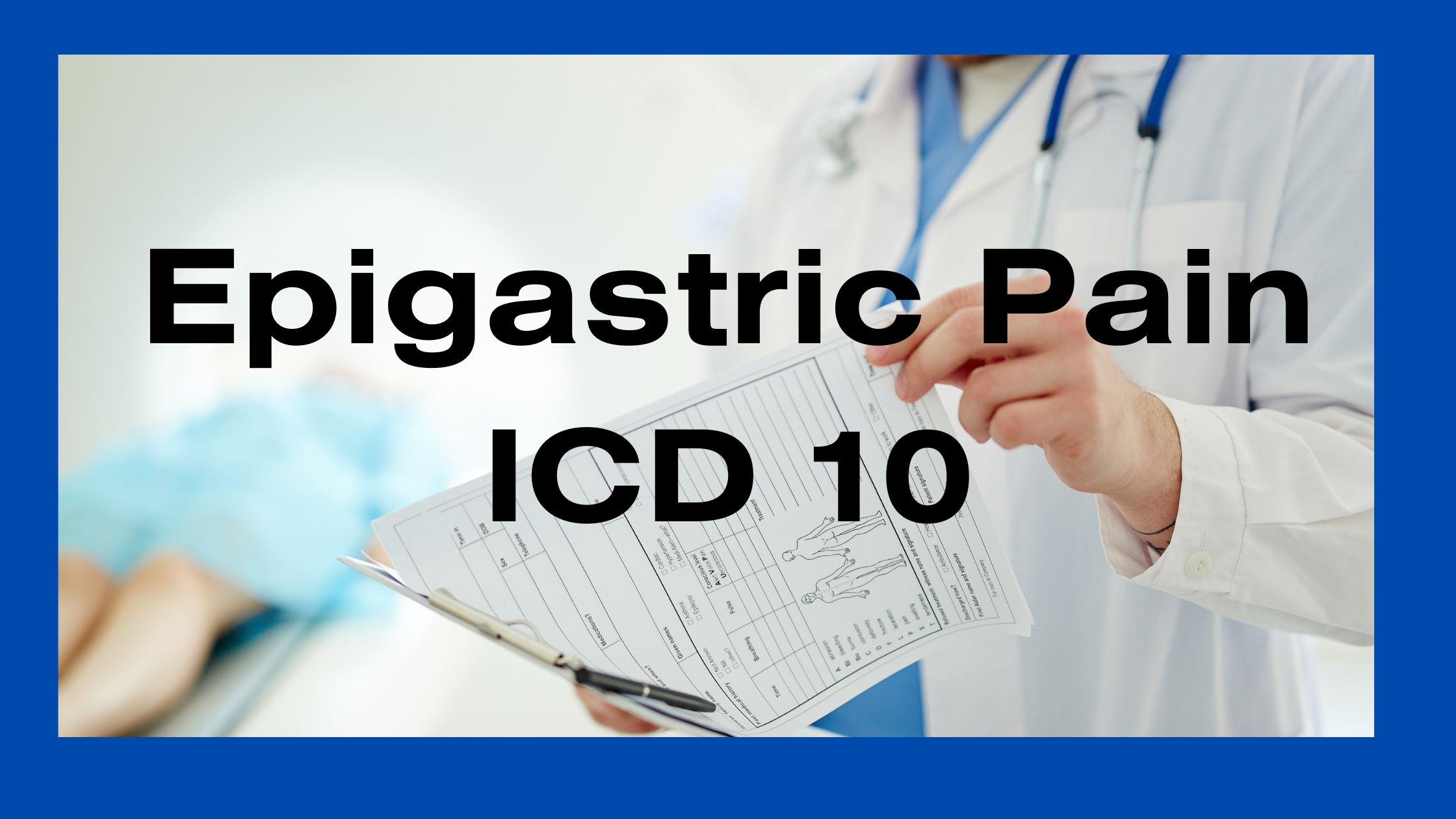Epigastric pain, which refers to discomfort or pain in the upper abdomen, can be caused by various underlying conditions. This comprehensive article will discuss the epigastric pain icd10 code, its causes, symptoms, and available treatment options to provide a better understanding of this condition.
Understanding Epigastric Pain:
Epigastric pain is characterized by discomfort or pain that originates from the upper abdomen, specifically the area between the chest and the belly button. It can vary in intensity and duration and may be described as burning, gnawing, or sharp. This type of pain can significantly impact an individual’s quality of life, making it important to identify the underlying cause and seek appropriate treatment.
ICD-10 Code for Epigastric Pain:
The International Classification of Diseases, Tenth Revision (ICD-10), offers a specific code to identify epigastric pain. The Epigastric pain ICD 10 is R10.13. Healthcare professionals use this code for accurate medical record-keeping and billing purposes. By utilizing this code, medical practitioners can effectively track and manage patients’ conditions related to epigastric pain.
- R10.13 – Epigastric Pain: Epigastric pain is centered in the upper-middle part of the abdomen, just below the ribcage. It may be related to issues with the stomach or the upper part of the small intestine. This code is used to describe such pain.
- R10.0 – Acute Abdomen: This code is used to describe severe, sudden-onset abdominal pain that may be indicative of a medical emergency. An acute abdomen can be caused by various conditions, such as appendicitis, gallbladder inflammation, or bowel obstruction.
- R10.1 – Pain Localized to Upper Abdomen: This code is used when a patient experiences pain primarily in the upper abdominal region. It is a general code for upper abdominal pain and does not specify a particular cause or location within the upper abdomen.
- R10.10 – Upper Abdominal Pain, Unspecified: This is a more general code for upper abdominal pain without specifying the exact location or cause within the upper abdomen.
- R10.11 – Right Upper Quadrant Pain: This code is used when the pain is specifically localized to the right upper quadrant of the abdomen. This area often corresponds to the location of the liver, gallbladder, and part of the small intestine.
- R10.12 – Left Upper Quadrant Pain: This code is used when the pain is specifically localized to the left upper quadrant of the abdomen. This area often corresponds to the location of the spleen, stomach, and part of the pancreas.
- R10.2 – Pelvic and Perineal Pain: This code is used when a patient experiences pain in the pelvic and perineal region, which includes the lower part of the abdomen and the area between the genitals and anus.
- R10.3 – Pain Localized to Other Parts of Lower Abdomen: This code is used for abdominal pain that is not in the upper abdomen and not in the pelvic or perineal region. It refers to pain in other parts of the lower abdomen.
- R10.30 – Lower Abdominal Pain, Unspecified: Similar to code R10.10 for upper abdominal pain, this code is a general category for lower abdominal pain without specifying the exact location or cause.
- R10.31 – Right Lower Quadrant Pain: This code is used when the pain is specifically localized to the right lower quadrant of the abdomen. This area often corresponds to the location of the appendix.
- R10.32 – Left Lower Quadrant Pain: This code is used when the pain is specifically localized to the left lower quadrant of the abdomen. This area includes the lower part of the colon and other structures.
- R10.33 – Periumbilical Pain: Periumbilical pain is centered around the area of the navel (umbilicus). It can be associated with various abdominal conditions, and this code is used to describe such pain.
- R10.8 – Other Abdominal Pain: This is a general code for abdominal pain that does not fit into the specific categories mentioned above. It can be used when the location or cause of the pain is not well-defined.
- R10.81 – Abdominal Tenderness: This code is used to indicate abdominal tenderness without specifying the location. Abdominal tenderness often indicates discomfort or pain upon palpation (touching) of the abdomen and can be a symptom of various underlying issues.
- R10.811 – Right Upper Quadrant Abdominal Tenderness: Similar to the above code, this code specifies tenderness in the right upper quadrant of the abdomen.
- R10.812 – Left Upper Quadrant Abdominal Tenderness: This code specifies tenderness in the left upper quadrant of the abdomen.
Causes of Epigastric Pain:
1. Gastroesophageal Reflux Disease (GERD):
GERD is a condition in which stomach acid flows back into the esophagus, causing irritation and pain. It occurs when the lower esophageal sphincter (LES) weakens or relaxes, allowing stomach acid to rise.
– Symptoms of GERD may include heartburn, regurgitation (the sensation of acid or food coming back up), and a sour taste in the mouth. These symptoms can be exacerbated by certain foods, obesity, pregnancy, or hiatal hernia.
2. Peptic Ulcers:
Peptic ulcers are open sores that develop on the lining of the stomach or the upper portion of the small intestine. They are commonly caused by an infection with Helicobacter pylori (H. pylori) bacteria or by prolonged use of NSAIDs.
– H. pylori infection weakens the protective lining of the stomach, allowing stomach acid to damage the underlying tissue. NSAIDs, such as aspirin or ibuprofen, can also disrupt the stomach’s protective barrier, leading to ulcer formation.
– Symptoms of peptic ulcers may include burning pain in the epigastric region, bloating, belching, nausea, and vomiting. In severe cases, complications like bleeding or perforation may occur.
3. Gallstones:
Gallstones are hardened deposits that form in the gallbladder, a small organ located beneath the liver. When these stones obstruct the bile ducts, it can result in intense epigastric pain known as biliary colic.
– Biliary colic is characterized by excruciating pain in the upper abdomen, typically radiating to the back or right shoulder. Other symptoms may include nausea, vomiting, and jaundice (yellowing of the skin and eyes).
4. Pancreatitis:
Pancreatitis is inflammation of the pancreas, a gland located behind the stomach. This condition can cause severe epigastric pain, which may be accompanied by nausea, vomiting, and tenderness in the abdominal area.
– Pancreatitis can be acute or chronic. Acute pancreatitis is often triggered by gallstones or excessive alcohol consumption, while chronic pancreatitis is typically associated with long-term alcohol abuse.
5. Gastritis:
Gastritis refers to inflammation of the stomach lining. It can be caused by bacterial or viral infections, excessive alcohol consumption, prolonged use of NSAIDs, or autoimmune disorders.
– Symptoms of gastritis may include epigastric pain, nausea, vomiting, bloating, and a feeling of fullness in the upper abdomen. In severe cases, gastritis can lead to gastrointestinal bleeding or stomach ulcers.
6. Gastrointestinal Obstruction:
Gastrointestinal obstruction occurs when there is a blockage in the digestive tract, impeding the normal passage of food and fluids. This blockage can result from factors such as tumors, adhesions (scar tissue), or hernias.
– Symptoms of gastrointestinal obstruction include severe epigastric pain, bloating, vomiting, and the inability to pass gas or stool. Prompt medical intervention is necessary to relieve the obstruction and prevent complications.
7. Functional Dyspepsia:
Functional dyspepsia is a chronic condition characterized by recurring or persistent pain or discomfort in the upper abdomen. The exact cause of functional dyspepsia is unknown, but factors such as stress, anxiety, certain foods, and gastric motility disorders may play a role.
– Symptoms of functional dyspepsia can vary but commonly include epigastric pain or discomfort, bloating, early satiety (feeling full after eating small amounts), and nausea. Although not life-threatening, functional dyspepsia can significantly impact a person’s quality of life.
Symptoms of Epigastric Pain:
In addition to the pain itself, individuals experiencing epigastric pain may also have associated symptoms, including:
- Heartburn or acid reflux: A burning sensation in the chest or throat due to stomach acid rising into the esophagus.
- Nausea and vomiting: Feeling sick to the stomach and expelling the contents of the stomach through the mouth.
- Bloating and belching: Excessive gas accumulation in the abdomen, leading to discomfort and the release of gas through the mouth.
- Loss of appetite: A reduced desire to eat or a decreased interest in food.
- Weight loss: Unintentional or significant reduction in body weight.
- Fatigue: Extreme tiredness or lack of energy.
- Black, tarry stools (indicative of gastrointestinal bleeding): Dark, sticky stools resulting from bleeding in the upper digestive tract.
Treatment Options for Epigastric pain:
The treatment for epigastric pain depends on the underlying cause. Here are some common approaches to managing this condition:
1. Lifestyle Modifications:
– For conditions like GERD and gastritis, certain lifestyle changes can help alleviate symptoms. These changes may include avoiding trigger foods (e.g., spicy or fatty foods), maintaining a healthy weight, quitting smoking, and reducing stress.
– Practicing good eating habits, such as eating smaller meals more frequently and avoiding lying down immediately after eating, can also help manage symptoms associated with epigastric pain.
2. Medications:
– Medications are commonly used to manage various causes of epigastric pain. Antacids can provide temporary relief by neutralizing stomach acid, while proton pump inhibitors (PPIs) and H2 blockers help reduce acid production in the stomach.
– In cases of peptic ulcers caused by H. pylori infection, a combination of antibiotics is usually prescribed to eradicate the bacteria. Additionally, pain relievers, enzyme supplements, and medications to aid digestion might be recommended for specific conditions.
3. Surgical Interventions:
– In certain cases, surgical interventions may be necessary to address the underlying cause of epigastric pain. For example, if gallstones are causing biliary colic, a cholecystectomy (removal of the gallbladder) may be performed.
– Gastrointestinal obstructions caused by tumors or adhesions might require surgical repair through laparoscopic or open surgery. Surgical interventions aim to relieve the obstruction and restore normal digestive function.
4. Management of Underlying Conditions:
– For chronic conditions such as pancreatitis or functional dyspepsia, managing the underlying cause is crucial. This often involves a combination of lifestyle changes, medication, and regular follow-ups with a healthcare professional.
– Patients with pancreatitis may need to abstain from alcohol, follow a low-fat diet, and take pancreatic enzyme supplements. Managing stress and avoiding trigger foods are essential for individuals with functional dyspepsia.
Conclusion:
Epigastric pain can significantly impact an individual’s quality of life, making it important to identify and address the underlying cause. The ICD-10 code for epigastric pain (R10.13) helps healthcare professionals accurately document and manage this condition for effective treatment and billing purposes. If you experience persistent or severe epigastric pain, it is essential to consult a healthcare provider for a proper diagnosis and personalized treatment plan. Seeking timely medical attention can help alleviate symptoms, manage the underlying cause, and improve overall well-being.
FAQs:
Ans. The ICD-10 code for epigastric pain is R10.13.
Ans. The common causes of epigastric pain include gastroesophageal reflux disease (GERD), peptic ulcers, gallstones, pancreatitis, gastritis, gastrointestinal obstruction, and functional dyspepsia.
Ans. The associated symptoms of epigastric pain may include heartburn or acid reflux, nausea and vomiting, bloating and belching, loss of appetite, weight loss, fatigue, and black, tarry stools (indicative of gastrointestinal bleeding).
Ans. The treatment options for epigastric pain depend on the underlying cause and may include lifestyle modifications, medications, surgical interventions, and management of underlying conditions.

